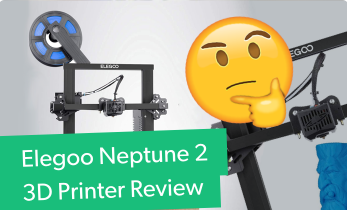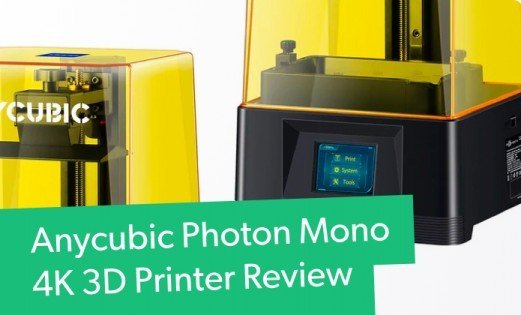3D Printer Myths Debunked
3D printing remains one of the hottest maker topics. However, as often as it's discussed, 3D printing is many times misunderstood. There are tons of 3D printing myths, from misconceptions about what you can print to its applications, and even technical processes. Here are the top 3D printing myths debunked!
1. 3D Printers are Expensive
Probably the biggest 3D printing myth is that 3D printers are expensive. In reality, 3D printers can be expensive, but loads of affordable 3D printers populate the market. Notably, the Ender3Pro, Elegoo Neptune, and mind-blowingly affordable yet accurate Elegoo Mars are some of the best 3D printers under $500. At the opposite end of the spectrum, you'll find 3D printers well over $1,000 such as the Dremel DigiLab 3D45 and Formlabs Form 2, the latter of which retails for just shy of $4,000. The Ultimaker S5 with an almost $6K price tag makes that look cheap. Sure, you can drop thousands of bucks on a 3D printer, but an increasing number of budget-oriented 3D printers continue to chisel 3D printing as an accessible hobby for makers.
2. 3D Printed Guns Will Abound
When a London, UK student was arrested for 3D printing a firearm, this incident unsurprisingly made headlines. It's certainly possible to 3D print a gun. However, media outlets often sensationalize the danger of 3D printed firearms. First of all, the majority of these are made with filament such as PLA or ABS, and are therefore susceptible to breaking. Basically, a gun made entirely of 3D printed plastics isn't going to function well. It's going to need metal parts which should assuage fears of sneaking through metal detectors. Moreover, a DIY firearm of any type isn't going to function nearly the same as a store-bought gun. That's not to say you should 3D print a firearm: quite bluntly, you shouldn't. But also don't be concerned that 3D printers will be churning out firearms en masse any time soon.
3. There are no Practical 3D Printing Applications
One of the biggest questions I get when discussing 3D printers with friends is what you can actually use a 3D printer for. Thankfully, the answer is pretty broad. You can print anything from miniature decorations for your desk such as chess pieces and movie replica statues like a Terminator T800 endoskeleton to replacement parts for your house. There are tons of useful things to 3D print, from cellphone holders to headphone stands, salt and pepper shakers, or even tools.
4. It's Difficult to Get Started 3D Printing
3D printing can seem pretty daunting, and for good reason. Creating something from seemingly nothing sounds challenging. Make no mistake, errors will occur. But getting started with 3D printing shouldn't be terrifying. Most problems are pretty easy to identify, especially with the plethora of online 3D printing resources, from troubleshooting tips to forums. Snagging a 3D printer with features such as a self-leveling bed, or one of the best 3D printers for beginners certainly helps simplify your 3D printing journey.
5. You can 3D Print Anything
Although you can 3D print many items, from geeky miniatures to household items, and even food, you can't quite 3D print everything. For instance, you can't 3D print living creatures. Other significant 3D printing limitations include size, weight, and density. The size of a build platform prevents massive creations. Sure, workarounds such as splitting up large objects into smaller bits, then printing in sections and putting the final piece together circumvent 3D printing limits. Still, you can't 3D print whatever you want, especially when considering material.
Generally, 3D printers use material such as PLA, ABS, and resin to create plastic models. There's also wood and metal 3D printing which isn't quite as common as plastic 3D printing. Accessibility of printing with materials like marble, concrete, and sand is rather sparse since it requires a specialized printer. Furthermore, speed prevents the feasibility of 3D printing anything. Despite many iterative advancements in 3D printing technology, it's still pretty slow, even for smaller objects. Since the process isn't terribly fast, and speed in 3D printing often coming at the expense of quality, 3D printing isn't able to handle any production.
6. Organs can be 3D Printed and Will Replace Organ Donor
3D printed organs sort of exist, but sensationalized headlines blow the truth out of proportion. Organovo created a 3D printed human liver, but it was for drug testing, and remained unsuitable for organ transplant. Among the greatest obstacles in 3D printing organs, there's vascularization. While building tissue isn't too challenging, it's difficult to replicate blood vessel networks which are used for transporting nutrients and oxygen throughout organs. Advancements continue to hone various components in organ 3D printing, but we're not ready for prime time when it comes to a fully-functioning, transplantable human 3D printed organ.
7. 3D Printing is Purely for Filament
Admittedly, FDM or filament-based 3D printers are easily the most common for household use. But filament is far from the only 3D printable material. Resin is increasingly common, especially among power users seeking top-notch quality. 3D printing with wood, concrete, marble, glass, and a slew of other materials is possible. Yet you won't find many consumer-facing printers capable of handling certain materials, notably concrete.
3D Printing Myths Debunked - Final Thoughts
3D printing is a fun, worthwhile hobby. Reasons to get into 3D printing include learning opportunities, the ability to create useful objects, and simply hobbyism. However, it's an often misunderstood space, with many myths about 3D printing still circulating. Currently, 3D printing does have its limitations, particularly with borderline theoretical practices like 3D printing organs. While you can print many items, limitations prevent you from being able to make anything you desire; we haven't quite created replicators from "Star Trek." Thankfully, some 3D printing fallacies like extreme cost of 3D printers and lack of practical applications mean that 3D printing only becomes more accessible for the average user.
Check out the best 3D printing software options on the market to elevate your 3D printing game!














































Leave your feedback...